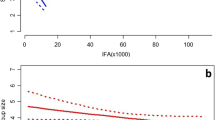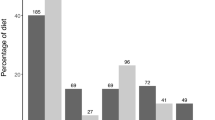Abstract
Social systems can be defined based on their degree of fission-fusion dynamics, which depends on party characteristics (i.e., spatial cohesion, party size, and sex-age composition). Although the ecological and ethological causes of fission-fusion dynamics are still under revision, fruit availability seems to be a main factor in party formation in primates. We therefore explored ecological (i.e., fruit availability as an indicator of food competition) and ethological factors (i.e., travel distance) related to fission-fusion dynamics using our own agent-based simulation model. We compared the simulation results from the model with field data obtained from the movement patterns of a wild group of red-capped mangabeys (Cercocebus torquatus) (Dolado et al. 2016, Folia Primatol 87:197–212) and found that they were consistent with field data obtained on C. torquatus in that they showed similar patterns of seasonal fission-fusion dynamics. Moreover, the results suggest that the fission-fusion dynamics observed in simulations can match patterns of travel distance of arboreal species subject to food competition that reflects behavioral flexibility to adapt to environmental conditions shown by C. torquatus in the field.
Significance statement
We have developed an agent-based model that reproduces the seasonal fission-fusion dynamics shown by a wild group of C. torquatus on the Atlantic coast of Gabon. The results of our simulations suggest that fission-fusion dynamics are an emergent behavior and that agent-based models are a good tool for exploring emergent behaviors in silico. Moreover, the agent-based simulation approach provides helpful new insights for future field studies on fission-fusion dynamics.



Similar content being viewed by others

References
Anderson DP (2002) Factors influencing fission-fusion grouping in chimpanzees in the Taï National Park, Côte d’Ivoire. In: Watts D, Mitani J, Boesch C, Hohmann G, Marchant L (eds) Behavioural diversity in chimpanzees and bonobos. Cambridge University Press, Cambridge, pp 90–101
Aureli F, Schaffner CM, Boesch C et al (2008) Fission-fusion dynamics. New research framework. Curr Anthropol 49:627–654
Beauchamp G, Belisle M, Giraldeau L (1997) Influence of conspecific attraction on the spatial distribution of learning foragers in a patchy habitat. J Anim Ecol 66:671–682
te Boekhorst I, Hogeweg P (1994) Effects of tree size on travelband formation in orang-utans: data analysis suggested by a model study. In: Brooks R, Maes P (eds) Artificial Life IV. MIT Press, Cambridge, pp 119–129
Bonnell TR, Sengupta RR, Chapman CA, Goldberg TL (2010) An agent-based model of red colobus resources and disease dynamics implicates key resource sites as hot spots of disease transmission. Ecol Model 221:2491–2500
Bonnell TR, Campenni MC, Chapman CA, Gogarten JF, Reyna-Hurtado R, Teichroeb JA, Wasserman MD, Sengupta R (2013) Emergent group level navigation: an agent-based evaluation of movement patterns in folivorous primate. PLoS One 8:e78264
Boyer D, Ramos-Fernández G, Miramontes O, Mateos JL, Cocho G, Larrald H, Ramos H, Rojas F (2006) Scale-free foraging by primates emerges from their interaction with a complex environment. Proc R Soc Lond B 273:1743–1750
Campbell AF, Sussman WA (1994) The value of radio tracking in the study of neotropical rain forest monkeys. Am J Primatol 32:219–301
Chapman CA (1995) Primate seed dispersal: coevolution and conservation implications. Evol Anthropol 4:74–82
Chapman CA, Chapman LJ, Wanghan R, Hunt K, Gebo D, Gardner L (1992) Estimators of fruit abundance of tropical tree. Biotropica 24:527–531
Chapman CA, White FJ, Wrangham RW (1993) Defining subgroup size in fission-fusion societies. Folia Primatol 61:31–34
Chapman CA, Wrangham RW, Chapman LJ (1995) Ecological constraints on group size: an analysis of spider monkey and chimpanzee subgroups. Behav Ecol Sociobiol 36:59–70
Clutton-Brock TH, Harvey PH (1977) Species differences in feeding and ranging behavior in primates. In: Clutton-Brock TH (ed) Primate ecology. Academic Press, London, pp 557–584
Cooke CA (2012) The feeding, ranging and positional behaviors of Cercocebus torquatus, the red-capped mangabey in Sette Cama, Gabon: a phylogenetic perspective. PhD dissertation, Ohio State University, Columbus
Cooke CA (2014) Crab predation by red-capped mangabeys (Cercocebus torquatus) in Sette Cama, Gabon. Afr J Ecol 53:378–380
Couzin ID (2006) Behavioral ecology: social organization in fission-fusion societies. Curr Biol 16:169–171
R Development Core Team (2013) R: a language and environment for statistical computing. R Foundation for Statistical Computing, Vienna https://www.r-project.org/
Dolado R, Beltran FS, Quera V (2014) Modeling the emergence of social structure from a phylogenetic point of view. J Artif Soc Soc Simul 17:8
Dolado R, Cooke C, Beltran FS (2016) How many for lunch today? Seasonal fission-fusion dynamics as a feeding strategy in wild red-capped mangabeys (Cercocebus torquatus). Folia Primatol 87:197–212
Dunbar RIM (1988) Primate social systems. Cornell University Press, Ithaca
Enquist BJ, Niklas KJ (2001) Invariant scaling relations across plant communities. Nature 410:655–660
ESRI (2011) ArcGIS desktop: release 10. Computer software. Environmental Systems Research Institute, Redlands
Evers E, de Vries H, Spruijt BM, Sterck EHM (2012) Look before you leap-individual variation in social vigilance shapes socio-spatial group properties in an agent-based model. Behav Ecol Sociobiol 66:931–945
Goodall J (1968) The behaviour of free-living chimpanzees in the Gombe Stream Reserve. Anim Behav 1:165–311
Grove M, Pearce E, Dunbar RI (2012) Fission-fusion and the evolution of hominin social systems. J Hum Evol 62:191–200
Hemelrijk CK (1998) Risk sensitive and ambiguity reducing dominance interactions in a virtual laboratory. In: Pfeifer R, Blunberg B, Meyer JA, Wilson SW (eds) From animals to animals V. MIT Press, Cambridge, pp 255–262
Isbell LA, Pruetz JD, Mzuma BM, Young TP (1999) Comparing measures of travel distances in primates: methodological considerations and socioecological implications. Am J Primatol 48:87–98
Janson CH, Goldsmith M (1995) Predicting group size in primates: foraging costs and predation risks. Behav Ecol 6:326–336
Jones C, Sabater Pi J (1968) Comparative ecology of Cercocebus albigena (gray) and Cercocebus torquatus (Kerr) in Rio Muni, West Africa. Folia Primatol 9:99–113
Kinnaird MF (1990) Behavioral and demographic responses to habitat change by the Tana River crested mangabey (Cercocebus galeritus galertitus). PhD dissertation, University of Florida, Gainesville
Kummer H (1971) Primates societies. Aldine-Atherton, Chicago
Lee M, Alonso A, Dallmeier F, Campbell P, Pauwels OSG (2006) The Gamba Complex of protected areas: an illustration of Gabon’s diversity. Bull Biol Soc Wash 12:229–242
Lusseau D (2003) The emergent properties of a dolphin social network. Bull Biol Soc Wash 270:186–188
Maes P (1997) Modeling adaptive autonomous agents. In: Langton CG (ed) Artificial life: an overview. MIT Press, Cambridge, pp 135–162
Marlowe FW (2005) Hunter-gatherers and human evolution. Evol Anthropol 14:54–67
McGraw WS, Vick AA, Daegling DJ (2011) Sex and age differences in the diet and ingestive behaviors of sooty mangabeys (Cercocebus atys) in Taï Forest, Ivory Coast. Am J Phys Anthropol 144:140–153
Mitani M (1989) Cercocebus torquatus: adaptive feeding and ranging behaviours related to seasonal fluctuations of food resources in the tropical rain forest of south-western Cameroon. Primates 30:307–323
Newman MEJ, Girvan M (2004) Finding and evaluating community structure in networks. Phys rev E 69:026113
Newton-Fisher NE, Reynold V, Plumptre AJ (2000) Food supply and chimpanzee (Pan troglodytes schweinfurthii) party size in the Budongo Forest Reserve, Uganda. Int J Primatol 21:613–628
Niklas KJ, Midgley JJ, Rand RH (2003) Tree size frequency distributions, plant density, age and community disturbance. Ecol Lett 6:405–411
Nishida T, Hiraiwa-Hasegawa M (1987) Chimpanzees and bonobos: cooperative relationships among males. In: Smuts BB, Cheney DL, Seyfarth RM, Wrangham RW, Struhsaker TT (eds) Primate societies. University of Chicago Press, Chicago, pp 165–177
Ostro LET, Young TP, Silver SC, Koontz FW (1999) A geographic information system method for estimating home range size. J Wildl Manag 63(2):748
Poulsen JR, Clark CJ, Smith TB (2001) Seasonal variation in the feeding ecology of the grey-cheeked mangabey (Lophocebus albigena) in Cameroon. Am J Primatol 54:91–105
Puga-González I, Hildenbrandt H, Hemelrijk CK (2009) Emergent patterns of social affiliation in primates, a model. PLoS Comput Biol 5:e1000630
Ramos-Fernández G, Boyer D, Gómez VP (2006) A complex social structure with fission-fusion properties can emerge from a simple foraging model. Behav Ecol Sociobiol 60:536–549
Ren B, Li D, Garber PA, Li M (2012) Fission-fusion behavior in Yunnan snub-nosed monkeys (Rhinopithecus bieti) in Yunnan, China. Int J Primatol 33:1093–1109
Robbins MM, Robbins AM (2004) Simulation of the population dynamics and social structure of the Virunga mountain gorillas. Am J Primatol 63:201–223
van Schaik CP (1989) The ecology of social relationships amongst female primates. In: Standen V, Foley RA (eds) Comparative socioecology: the behavioral ecology of humans and other mammals. Blackwell, Oxford, pp 195–218
Sellers WI, Hill RA, Logan BS (2007) An agent-based model of group decision making in baboons. Philos Trans R Soc B 362:1699–1710
Sueur C, Petit O, Deneubourg JL (2009) Selective mimetism at departure in collective movements of Macaca tonkeana: an experimental and theoretical approach. Anim Behav 78:1087–1095
Sueur C, King AJ, Conraldt L, Kerth G, Lusseau D, Mette-Hofmann C, Williams L, Zinner D, Aureli F (2011) Collective decision-making and fission-fusion dynamics: a conceptual framework. Oikos 120:1608–1617
Thierry B (2004) Social epigenesist. In: Thierry B, Singh M, Kaumanns W (eds) Macaque societies: a model for the study of social organizations. Cambridge University Press, Cambridge, pp 267–290
Wanker R (2002) Social system and acoustic communication of spectacled parrotlets (Forpus conspicillatus): research in captivity and in the wild. In: Mette-Hofman C, Ganzlosser U (eds) Bird research and breeding. Filander, Fürth, pp 83–108
Watts DP (1991) Strategies of habitat use by mountain gorillas. Folia Primatol 56:1–16
Wilensky U (1999) NetLogo. Center for connected learning and computer-based modeling. Northwestern University, Evanston http://ccl.northwestern.edu/netlogo/
Wrangham RW (1980) An ecological model of female-bonded primate groups. Behaviour 75:262–300
Acknowledgements
This project was funded by Fundació Barcelona Zoo (2012 Floquet de Neu grant) and the Department of Psychology, University of Barcelona. We would like to thank our field assistants and the World Wildlife Foundation in Gamba for their logistical support getting in and out of the forest. We would also like to thank the reviewers for their constructive criticism and recommendations, which helped us improve our article.
Author information
Authors and Affiliations
Corresponding author
Ethics declarations
Funding
This study was funded by Fundació Barcelona Zoo (2012 Floquet de Neu grant) and the Department of Psychology (Special Research Actions), University of Barcelona.
Conflict of interest
The authors declare that they have no conflict of interest.
Ethical statement
All applicable international, national, and/or institutional guidelines for the care and use of animals were followed. Research authorizations were obtained from the Centre National de la Recherche Scientifique of Gabon (No. AvAR0017/14) and the Agence Nationale des Parcs Nationaux (No. AE140011). All procedures performed in studies involving animals were in accordance with the ethical standards of these institutions.
Data availability statement
The datasets during and/or analyzed during the current study are available from the corresponding author on reasonable request.
Additional information
Communicated by R. Noë
Rights and permissions
About this article
Cite this article
Dolado, R., Gimeno, E. & Beltran, F.S. Modeling the emergence of seasonal fission-fusion dynamics in red-capped mangabeys (Cercocebus torquatus). Behav Ecol Sociobiol 71, 100 (2017). https://doi.org/10.1007/s00265-017-2331-3
Received:
Revised:
Accepted:
Published:
DOI: https://doi.org/10.1007/s00265-017-2331-3



